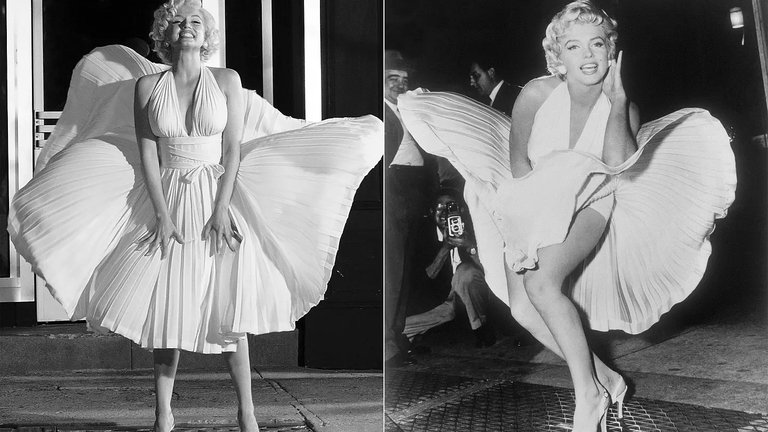" Blonde " movie | How did Marilyn Monroe absent and feminists flare up and Kennedy get the Blowjob?
"Shit Marilyn Monroe.. She's Not Here".

Source
With this phrase, Marilyn Monroe angrily ends the phone call, in one of the scenes of the movie Blonde, which is currently available on Netflix. To a large extent, this sentence sums up the spirit of the movie
This time we don't see Marilyn Monroe's glow of fun and temptation, as we used to in her films, but we watch Norma Jean, the psychologically broken child who has grown up, and has created for herself a funny cinematic identity named Marilyn Monroe.

Throughout the events, Australian director Andrew Dominic narrates the difference between her image and her conception of herself, and her mental image of the audience and those around her.
From a miserable childhood in which the father was absent, and the mother was the first to abuse Monroe, to the world of Hollywood and exposure to sexual exploitation and harassment from producers and politicians, to frustrating marriages, and desperate attempts to become pregnant and have children, Marilyn Monroe seeks to make up for what she missed, by turning to the loving mother who did not get had her in her whole life.
Blonde movie chronicles the life of its heroine, presenting her primarily as a victim in search of love, respect, and appreciation, in a world that sees only a beautiful sex doll and a petty girl who can hardly read a book.
The visually significant achievement here is the dramatic adaptation of iconic images and iconic moments in Marilyn Monroe films, into the dramatic fabric of Blonde movie.
The iconic scene, for example, the Seven year itch, when Monroe lets her white dress flutter and exposes her charms, is linked here to a deeply traumatic broken moment for the heroine.

Source
Famous photos, which Marilyn Monroe fans know as joyful moments in her life, appear here linked to her failures and mishaps.
This approach alone will likely ensure that the film will, over time, become the most famous introduction to Marilyn Monroe's life
Interestingly, the film is based on the novel of the same title - Blonde - whose author, Joyce Carol Oates, always denies the idea that it is an accurate narrative of Marilyn Monroe's life as much as it is a fictional narrative based on events from her life, and offers liberally psychological readings of the protagonist during these situations.
Of course, not all of the above would have worked without the selection of a suitable actress for the role of Marilyn Monroe.
Ana De Armas succeeded in the mission. As much as she has proven to be more than just a pretty face in previous films, Marilyn Monroe's role here can be considered her most important role.
Blonde gives Ana De Armas endless opportunities to flex her muscles as an actress, with emotional scenes like crying, anger and breakdown. But it also requires her, in other passages, to become discreet, not communicating with those around her, and hiding any feelings or frustrations from them.
In other circumstances, I would have considered Ana De Armas, from now on, the fiercest contender for the Oscar for best actress this season. But her path to victory became very difficult for non-artistic reasons:
In several scenes in Blonde, the director resorts to shocking formulas, chief among them a scene in which Marilyn Monroe offers oral sex to President Kennedy, who treats her like a professional whore.
And another tense scene, in which the camera is positioned inside the womb of the heroine, and we see Monroe as she decides to perform an abortion on her fetus, and then tries to retreat in vain.
And the third imaginary, in which she imagines that she is talking to a fetus inside her womb.
But all of the aforementioned daring scenes and dramatic ideas were enough elements for a new feminist headache wave on Twitter, and a campaign of moral bidding against the filmmakers, which included dozens of outlandish accusations such as:
1- Presenting a feminist character with a biased male perspective.
2- Allowing a director (male) to take up the career of an artist (female).
3- Insulting the memory of an important artist and presenting her as a weak and psychologically fragile figure.
4- Providing dramatic content against the freedom of abortion.
5- Criminalization of women who perform abortions
!hivebits
Success! You mined 1.0 HBIT on Wusang: Isle of Blaq. | tools | wallet | discord | community | daily <><

And, you found a BLAQ pearl (BLAQ)!
Check your bonus treasure tokens by entering your username at an H-E explorer or take a look at your wallet.
Read about Hivebits (HBIT) or read the story of Wusang: Isle of Blaq.
Very interesting things the movie discuss right?

!1UP
Yess I love it , !LUV !PIZZA
@cryptohaytham(1/1) gave you LUV. tools | wallet | discord | community | <>< daily
tools | wallet | discord | community | <>< daily
HiveBuzz.me NFT for Peace
You have received a 1UP from @gwajnberg!
@cine-curator, @vyb-curator, @pob-curator
And they will bring !PIZZA 🍕.
Learn more about our delegation service to earn daily rewards. Join the Cartel on Discord.
!hivebits
Success! You mined 1.0 HBIT on Wusang: Isle of Blaq. | tools | wallet | discord | community | daily <><

And, you found a BLAQ pearl (BLAQ)!
Check your bonus treasure tokens by entering your username at an H-E explorer or take a look at your wallet.
Read about Hivebits (HBIT) or read the story of Wusang: Isle of Blaq.
I gifted $PIZZA slices here:
@cryptohaytham(1/5) tipped @gwajnberg (x1)
Learn more at https://hive.pizza!